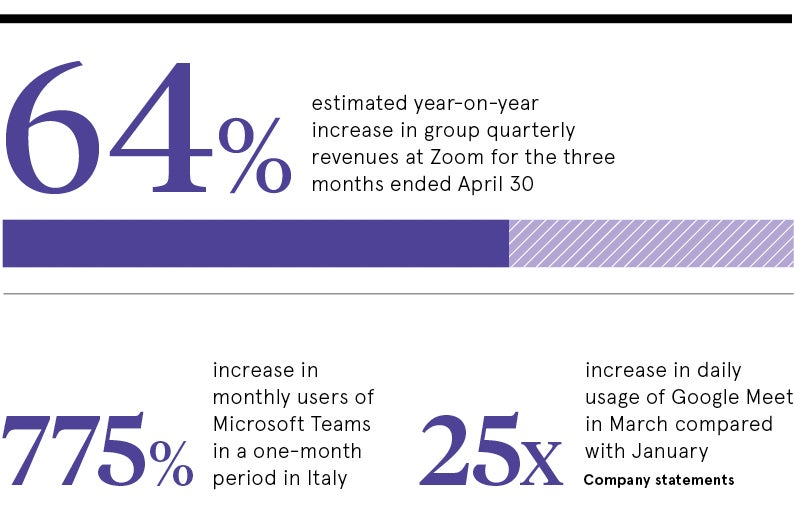It would be easy to generalise that technology has helped businesses to carry on working during the coronavirus outbreak. But delving deeper into what exactly has been the key to enabling people to work from home and keep business-critical services going, there is one constant: cloud computing.
While the likes of Zoom and Microsoft Teams are gaining traction with consumers and businesses alike, the reason millions of people can use this tech simultaneously is because of the benefits of cloud computing.
These benefits are well documented: cloud infrastructure enables companies to scale up and down with flexibility so they can cope with volatile conditions like those currently being experienced, while software-as-a-service, or SaaS, apps mean companies do not have to worry about scaling up their hardware and bandwidth to cope with huge demands.
Cloud technology enables staff to stay home
Depending on the type of business, the benefits of cloud computing may vary. For instance, for many organisations it will simply be the case of facilitating home working.
“The cloud has been absolutely essential and I really don’t know how we’d have coped without it. If we were still reliant on physical datacentres, we wouldn’t have been able to expand so quickly,” says Patrick Babic, service owner for the end-user computing team at energy giant Centrica.
“With staff forced to work from home, Citrix Cloud has enabled them to securely connect to the network through their home broadband and with their own device. This simply wouldn’t have been the case without the cloud.”
The company had Citrix Cloud in place prior to the pandemic, but had to expand the capacity of users and servers in the cloud because of so many employees working from home. This was the key benefit of cloud computing for Centrica from the outset, the ability to easily flex up and down when required in a short space of time.
Scaling up thanks to cloud adoption
The scaling-up aspect of cloud is particularly important with ecommerce. Adam Taylor, co-founder and chief executive of PetShop.co.uk, says that as the company had shifted to a cloud strategy before COVID-19, with NetSuite’s cloud enterprise resource planning product, it had been able to cope with unprecedented demand.
“We’ve been told by manufacturers, such as Mars and Nestlé, that we’ve been able to scale up more swiftly than most of our competitors and this has been because of cloud infrastructure,” says Taylor.
“We’ve gone from packing and shipping 1,000 orders a day to 4,000 orders a day. We were able to scale up to meet this demand within the space of two days.”
According to Taylor, the benefits of cloud computing meant the company could order the stock in quickly, pack it and dispatch it more swiftly, and log all this in accounts. In addition, while other competitors’ websites had to be shut down because of the sheer volume of customers accessing online shopping during the COVID-19 lockdown, PetShop.co.uk’s website managed to stay robust.

No contact in contact centres
Customer services departments have been vital throughout this period, as customers do not have the option of any face-to-face contact. As a result of social distancing measures, contact centres have had to switch to remote working, while also dealing with an increase in calls, and cloud computing has been at the heart of enabling these organisations to manage demand.
Northern Ireland Water has installed the Cirrus Cloud Contact Centre to enable agents to work from home, provide a webchat portal and ensure payment card industry-compliant payments can still be made.
Meanwhile, in early-April, the London Borough of Waltham Forest deployed Amazon Connect, a cloud-based call centre, so it could handle calls from more than 3,000 residents and customers each day, which was 30 per cent more than before to the pandemic.
The product has also helped the borough to increase the service to be available seven days a week and ensure staff could work remotely, which was not possible with the previous technology it had in place.
Benefits of cloud computing cannot be ignored
Architectural practice Maber had been trialling NBS Chorus, a cloud service it uses to specify building products and which allows multiple users to work on the same specification. As a result of the pandemic, the company had to roll out the project to the whole company so people working from home can have access to the system to write specifications.
“It’s absolutely business critical; the drawings and modelling we do for the buildings are supported by the specifications, which tell the contractor exactly what they should be using to build the buildings. This would have held up our work if it wasn’t in the cloud,” says Nick Greenwood, architectural designer with Maber.
Employees at Maber had to use a VPN connection to get access to the company’s five servers, but many struggled to connect to the physical hardware. As a result, the company has moved all these local files over to the cloud-based platform Google Drive, resulting in greater efficiency. The company also uses a cloud-based business information modelling tool by Graphisoft.
According to Greenwood, the company would have struggled to keep working during the pandemic without cloud computing. As a result, even management have realised the benefits of cloud computing. “What it has done is prove the business can operate at a high level of efficiency, even remotely. So we don’t need to be sitting in offices next to one another; we can be spread all across the country and provide clients with the service they expect,” he says.
The reality is the pandemic has highlighted the importance of cloud computing and, if business leaders had not been convinced of its benefits before, they are likely to be now.
Cloud technology enables staff to stay home
Scaling up thanks to cloud adoption

